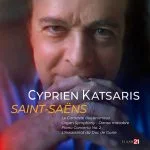

Composer: Charles Camille Saint-Saëns
Performer: Andrea Favalessa, Maria Semeraro
Format: FLAC (tracks)
Label: Brilliant Classics
Catalogue: 95421
Release: 2022
Size: 496 MB
Recovery: +3%
Scan: cover
Cello Sonata No. 1 in C Minor, Op. 32
01. I. Allegro
02. II. Andante tranquillo Sostenuto
03. III. Allegro Moderato
Cello Sonata No. 2 in in F Major, Op. 123
04. I. Maestosto, Largamente
05. II. Scherzo con variazioni. Allegro Animato
06. III. Romanza. Poco Adagio
07. IV. Allegro non troppo, Grazioso
Prior to the turn of the 20th century, Camille Saint-Saëns enriched the cello repertoire with two important compositions: his Cello Concerto No. 1 in A minor, Op. 33 and his Cello Sonata No. 1 in C minor, Op. 32, which he dedicated to cellist Jules Lasserre. The writer Emile Baumann hailed this first Cello Sonata as “a unique work”, a masterpiece. It was composed in the autumn of 1872, and its first public performance – with J. Reuschel on cello and the composer at the piano – was given on 26 March 1873 at the Salle Érard in Paris. The work is divided into three movements: the first and third have a tragic character, while the second offers an oasis of quiet serenity. The work opens with a dramatic Allegro in sonata form. The second movement stems from an organ improvisation performed by Saint-Saëns at Saint-Augustin. The final movement takes up the tumultuous and agitated character of the first and ends in an unrelenting race.
Some 30 years separate the Cello Sonata No. 2 in F major, Op. 123 from its predecessor. The fruit of laborious work, it was completed in early 1905. Saint-Saëns, adopting a typically self-deprecating tone – or perhaps merely to manage expectations – wrote to his publisher Jacques Durand on 16 March 1905, “naturally the Second Sonata will not measure up to the First: when La Fontaine published his second collection of fables, everyone declared it inferior to the previous one”. The Sonata No. 2 is structured in four movements, the first in sonata form with contrasting heroic and lyrical characters throughout. The second movement is a Scherzo with eight variations, each with its own identity while maintaining a link to the theme, one of them in the form of a fugue. The third movement is, in Saint-Saëns’ words, “a romance that will delight cellists”, and he wrote of its concluding section, “the Adagio will bring tears to sensitive souls”. The sonata ends with a playful, light Rondo in which both piano and cello engage in technical virtuosity and imitative games.



